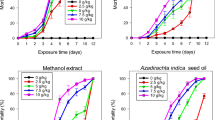Abstract
Vegetable oil and palm oil were tested for their ability to suppress the populations of Rhyzopertha dominica Fabr. and Dinoderus distinctus Lesne on maize, sorghum and wheat grains using three dosages of 1 ml/kg, 5 ml/kg and 10 ml/kg. A dosage of 5 ml/kg of each oil, completely protected the three grains from D. distinctus and R. dominica on maize grain. Vegetable oil at 10 ml/kg dosage controlled R. dominica on sorghum and wheat. Palm oil had a similar effect, but did not control R. dominica on wheat even at 10 ml/kg dosage. The populations of R. dominica when treated with 1 ml/kg dosage were not significantly lower at 5% level than the control, with the exception of maize. Percentage weight losses of all grains at 5 ml/kg and 10 ml/kg dosage were significantly lower at 5% level than the control. Oil treatment did not significantly affect the germination of grains and protected the grains from the two pests for only 3 months. The highest population of R. dominica after 2 months of reinfestation was 67 and the highest mean population of D. distinctus was 1.4. The use of vegetable oils in the management of insect pests in storage is discussed.
Résumé
On a expérimenté avec l’huile légumière et l’huile de palme pour savoir dans quelle mesure elles pourraient supprimer les populations de Rhyzopertha dominica Fabr et de Dinoderus distinctus Lesne sur les grains de maïs, de sorgho et de blé, en utilisant 3 doses, allant d’un ml/kg, 5 ml/kg et 10 ml/kg. Au dosage de 5 ml/kg pour chacune des huiles, on a pu protéger les trois grains, des activités de D. distinctus, d’une maniéré absolue. Au dosage de 5 ml/kg, on a pu seulement contrôler R. dominica sur les grains de maïs. Au dosage de 10 ml/kg l’huile legumiere a pu contrôler R. dominica sur le sorgho et le blé. L’huile de palme a été l’affet sembable comme l’huile de légumiére au dosage 10 ml/kg, mais elle n’a pa pu contrôler R. dominica sur le blé et ce dosage. A 5% de niveau et au traitement avec les doses d’un ml/kg, les populations de R. dominica étaient significativement plus basses que celles du contrôle, sauf en maïs. A 5% de niveau et au dosage de 5 ml/kg et 10 ml/kg les pertes on poids au pourcentage, étaient plus basses que celles du contrôle. Le traitement par huile na’avait pas significativement influé sur la germination des grains et les a protégés contre des deux ravageurs pendant trois mois seulement. La population la plus élevée de R. dominica après deux mois de réinfestation était 67, tandis que la moyenne la plus élevée de D. distinctus restait à 14. On a discuté l’emploi d’huile légumierés dans la contrôle d’insectes ravageus au stockage.
Similar content being viewed by others
References
Adu O. O. (1986) Protection of stored maize from Sitophilus zeamais (Mots) by vegetable oils. Rep. Nig. Stored Prod. Res. Inst. (1982), 33–40.
Ali S. I., Singh O. P. and Misra U. S. (1983) Effectiveness of plant oils against pulse beetle (Callosobruchus chinesis Linn.). Indian J. Entomol. 45, 6–9.
Burkholder W. E. and Ma M. (1985) Pheromones for monitoring and control of stored-product insects. A. Rev. Entomol. 30, 257–272.
Campion D. G., Hall D. R. and Prevett P. F. (1987) Use of pheromones in crop and stored products pest management: Control and monitoring. Insect Sci. Applic. 8, 737–741.
Egwuatu R. I. (1987) Current status of conventional insecticides in the management of stored product insect pests in the tropics. Insect Sci. Applic. 8, 695–701.
Hill J. and Schoonhoven A. U. (1981) Effectiveness of vegetable oil fractions in controlling the Mexican bean weevil on stored bean. J. econ. Entomol. 74, 478–479.
Ivbijaro M. F. (1984) Toxic effect of groundnut oil on the rice weevil Sitophilus oryzae (L.). Insect Sci. Applic. 5, 251–252.
Mummigatti S. G. and Ragunathan A. N. (1977) Inhibition of the multiplication of Callosobruchus chinensis by vegetable oils. J. Food. Sci. Technol. 14, 184–185.
Pereira J. (1983) The effectiveness of six vegetable oils as protectants of cowpeas and Bambara groundnuts against infestation by Callosobruchus maculatus (Coleoptera: Bruchidae). J.stored prod. Res. Info. 46, 25–30.
Saxena R. C. (1989) Insecticides from neem. In Insecticides from Plants (Edited by Armason J. T., Philogene J. R. and Morand P.), pp. 110–135. ACS Symposium Series 387, Washington, D.C.
Saxena R. C., Jilani G., Kareem A. A. (1988) Effect of neem on stored grain insects. In Focus on Phytochemical Pesticides (Edited by Jacobson M.), pp. 98–111. CRC Press, Boca Raton, Florida.
Singh S. R., Luse R. A., Leuschner K. and Nangju D. (1978) Groundnut oil treatment for the control of Callosobruchus maculatus during cowpea storage. J. stored Prod. Res. 14, 77–80.
Yadav I. D. (1987) Current status of conventional insecticides in stored product insect management in India. Insect Sci. Applic. 8, 703–707.
Yun-tai Q. I. and Burkholder W. E. (1981) Protection of stored wheat from the granary weevil by vegetable oils. J. Econ. Entomol. 74, 502–505.
Author information
Authors and Affiliations
Rights and permissions
About this article
Cite this article
Kumar, R., Okonronkwo, N.O. Effectiveness of Plant Oils Against Some Bostrychidae Infesting Cereals in Storage. Int J Trop Insect Sci 12, 77–85 (1991). https://doi.org/10.1017/S1742758400020567
Received:
Published:
Issue Date:
DOI: https://doi.org/10.1017/S1742758400020567
Key Words
- Rhyzopertha dominica
- Dinoderus distinctus
- vegetable oil
- palm oil
- maize
- sorghum
- wheat
- weight loss
- grain protection
- grain germination
- reinfestation
- pest management



